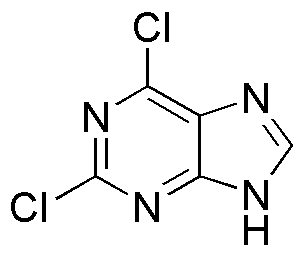2,6-Dichloropurine is widely utilized in research focused on:
- Pharmaceutical Development: This compound serves as a key intermediate in the synthesis of various antiviral and anticancer drugs, helping to create effective treatments for diseases like leukemia.
- Biochemical Research: It is used in studies related to nucleic acid metabolism, providing insights into DNA and RNA synthesis, which is crucial for understanding genetic disorders.
- Pesticide Formulation: 2,6-Dichloropurine is applied in the agricultural sector as a herbicide, offering an effective solution for weed control while minimizing crop damage.
- Analytical Chemistry: This compound is utilized as a standard in various analytical methods, aiding researchers in the accurate quantification of related substances in complex mixtures.
- Material Science: It plays a role in the development of new materials, particularly in creating polymers with enhanced properties for electronic applications.
General Information
Properties
Safety and Regulations
Applications
2,6-Dichloropurine is widely utilized in research focused on:
- Pharmaceutical Development: This compound serves as a key intermediate in the synthesis of various antiviral and anticancer drugs, helping to create effective treatments for diseases like leukemia.
- Biochemical Research: It is used in studies related to nucleic acid metabolism, providing insights into DNA and RNA synthesis, which is crucial for understanding genetic disorders.
- Pesticide Formulation: 2,6-Dichloropurine is applied in the agricultural sector as a herbicide, offering an effective solution for weed control while minimizing crop damage.
- Analytical Chemistry: This compound is utilized as a standard in various analytical methods, aiding researchers in the accurate quantification of related substances in complex mixtures.
- Material Science: It plays a role in the development of new materials, particularly in creating polymers with enhanced properties for electronic applications.
Documents
Safety Data Sheets (SDS)
The SDS provides comprehensive safety information on handling, storage, and disposal of the product.
Product Specification (PS)
The PS provides a comprehensive breakdown of the product’s properties, including chemical composition, physical state, purity, and storage requirements. It also details acceptable quality ranges and the product's intended applications.
Certificates of Analysis (COA)
Search for Certificates of Analysis (COA) by entering the products Lot Number. Lot and Batch Numbers can be found on a product’s label following the words ‘Lot’ or ‘Batch’.
Numéro de catalogue
Numéro de lot/série
Certificates Of Origin (COO)
This COO confirms the country where the product was manufactured, and also details the materials and components used in it and whether it is derived from natural, synthetic, or other specific sources. This certificate may be required for customs, trade, and regulatory compliance.
Numéro de catalogue
Numéro de lot/série
Safety Data Sheets (SDS)
The SDS provides comprehensive safety information on handling, storage, and disposal of the product.
DownloadProduct Specification (PS)
The PS provides a comprehensive breakdown of the product’s properties, including chemical composition, physical state, purity, and storage requirements. It also details acceptable quality ranges and the product's intended applications.
DownloadCertificates of Analysis (COA)
Search for Certificates of Analysis (COA) by entering the products Lot Number. Lot and Batch Numbers can be found on a product’s label following the words ‘Lot’ or ‘Batch’.
Numéro de catalogue
Numéro de lot/série
Certificates Of Origin (COO)
This COO confirms the country where the product was manufactured, and also details the materials and components used in it and whether it is derived from natural, synthetic, or other specific sources. This certificate may be required for customs, trade, and regulatory compliance.


